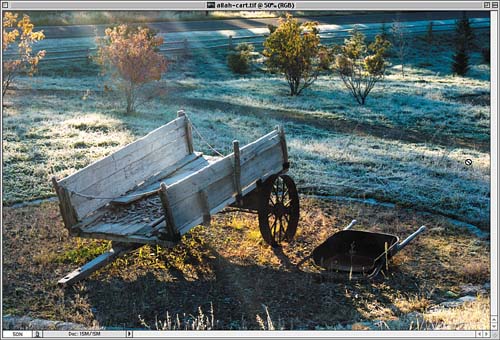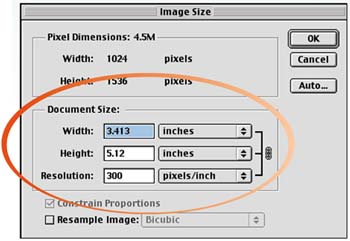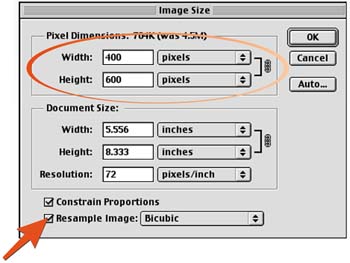| The size of a Photoshop image is measured in width and height, combined with a resolution value expressed as pixels or dots per inch (dpi). For example, you could have a 4x5 inch image at 300dpi. When resizing images, it is important to understand your minimum target resolution and to never go below it. (For example, in the print world, 300dpi is generally a target resolution.) Open the Image in Photoshop Choose File, Open and select the image file with which you want to work. 
Check the Image Size Choose Image, Image Size to open the Image Size dialog box. Make sure that the Constrain Proportions check box is enabled. This option ensures that the width-to-height ratios are maintained and prevents you from distorting the image as you resize it. 
Deselect Resample Image Make sure that the Resample Image check box is disabled. Deselecting this option keeps you from accidentally degrading image quality, especially if you plan to enlarge the image. Resampling works well when you want to resize and shrink the image, but resampling can be disastrous when you're trying to increase the dimensions. 
Enter Target Resolution Resolution refers to the number of dots per inch (dpi) or pixels per inch (ppi). For print, you want the image resolution to be between 225dpi and 300dpi; in contrast, the Web needs only 72dpi. Type the target resolution for this image in the Resolution field. As you do this, the dimensions (the Height and Width fields in the Document Size area) change, ensuring that image quality is not sacrificed. In this case, typing 300 in the Resolution field changed the dimensions from 14x21 to approximately 3x5. 
Enter Target Dimensions Because resolution is tied to image dimension, changing the dimension values modifies the target resolution you entered in Step 4. To change dimensions without altering resolution, enable the Resample Image check box and select Bicubic as the interpolation method. If you are designing for the Web, enter the dimension size in the fields in the Pixel Dimensions area; if you are designing for print, use the Document Size section. Specify the units of measurement in the pop-up menus (remember that image quality degrades if you enable the Resample Image check box), and then increase the image dimensions. Enter the desired dimensions and click OK to resize the image. 
How-To Hints Resizing Graphics When resizing graphics with hard edges and flat color, you may get better results by choosing Nearest Neighbor from the Resample Image pop-up menu rather than Bicubic. Nearest Neighbor creates very crisp lines and hard edges, preserving more of the original look of the design. Enlarging Size and Reducing Resolution You should avoid enlarging an image without decreasing resolution. For example, to enlarge a 4x5 image at 600dpi to 5x7, you should reduce the resolution to approximately 425dpi. This precaution keeps you from interpolating the image and losing detail. If you deactivate the Resample Image check box in the Image Size dialog box, Photoshop automatically makes these adjustments for you. |
|




